By Madeline Bocaro ©
https://linktr.ee/madelinerocks
© Madeline Bocaro, 2019. No part of this site may be reproduced in whole or in part in any manner without the permission of the copyright owner.
This is an excerpt from my Yoko Ono biography…

An all-embracing look at Yoko’s life and work in stunning detail.
Read all about it, see the reviews and
Order here:
Signed hard cover books are exclusively available at:
https://linktr.ee/conceptualbooks
Released June 12, 1972 (USA) / September 15 (UK)
John and Yoko moved from England to New York City in September 1971. John would never return to England. Yoko had lived and worked in NYC as an artist before meeting John. He called it ‘the hippest place on earth.” After an extended stay at the St. Regis Hotel, they settled in Greenwich Village – in a two-bedroom loft on Bank Street on November 1, 1971.

As we see in the 1971 Imagine film (at Tittenhurst Park in England) and their two Bed-ins for Peace in 1969 (in Toronto and in Montreal) the couple lived their lives and conducted business from a large bed in the small apartment, receiving lots of visitors and welcoming the press. They did the same on Bank Street, receiving photographers, musical and political guests.
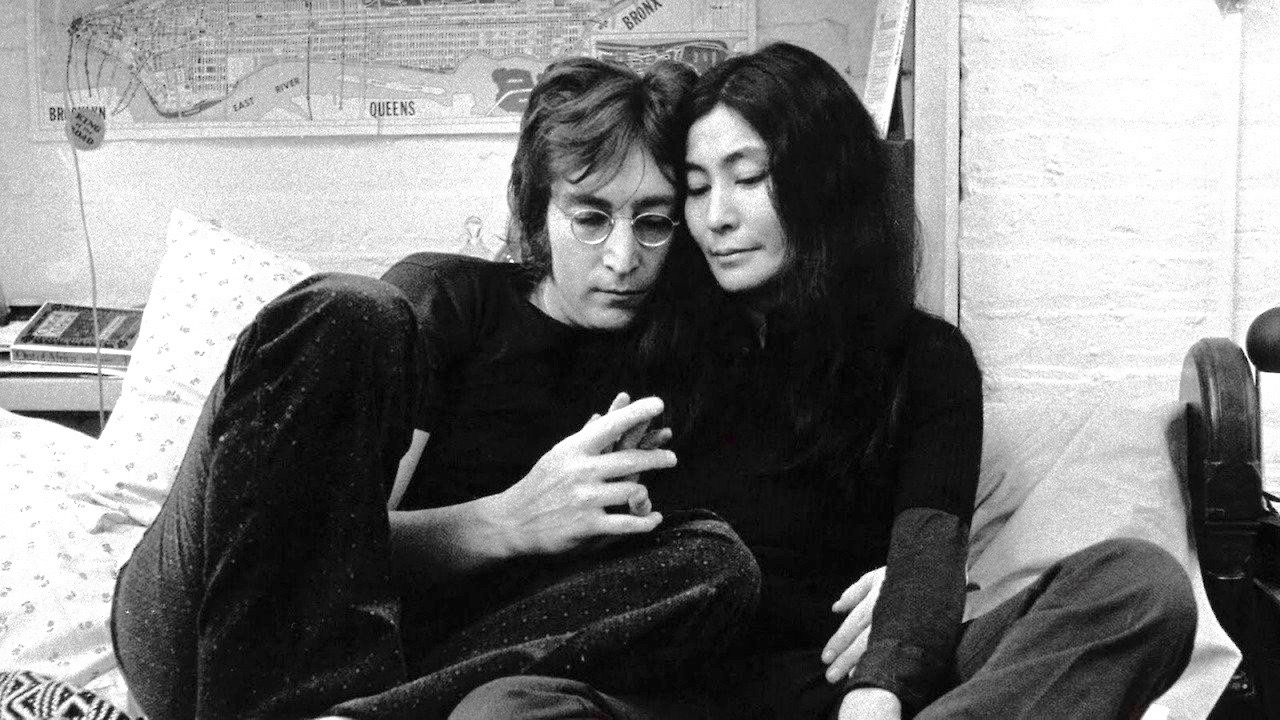
“Everywhere’s somewhere, and everywhere’s the same, really,
and wherever you are is where it’s at.
“But it’s more so in New York. It does have sugar on it, and I’ve got a sweet tooth.”
– John to Hendrik Hertzberg, The New Yorker, January 8, 1972
In New York City, the Lennons were immediately swept away in the socio-political rebellion of their new radical friends, Yippie leaders Abbie Hoffman and Jerry Rubin. (They are referenced in the song ‘Give Peace a Chance’ – John shouts, ‘Let’s hear it for the Hippies and the Yippies!’). John and Yoko were charmed by their intelligence and humorous tactics. Using ‘guerilla theater’ Abbie and Jerry (with their ‘merry band of pranksters’) confounded the establishment with their wacky antics such as throwing money around at The New York Stock Exchange, announcing the death of capitalism in 1967. They also disrupted the 1968 Democratic National Convention in Chicago by nominating a pig for president. Abbie’s Steal This Book revealed methods of getting food, items and services for free and also gave tips on how to make weapons and start your own revolution. Jerry Rubin’s Do It! was another radical tome. However, John and Yoko’s association with the pair and their demonstrative methods – which were a contrast to their own peaceful protests – was like playing with fire.
With their anti-war stance and interest in groups such as the Black Panthers, the Lennons soon had the FBI on their trail. Their life became a nightmare of surveillance and paranoia. The constant threat of deportation loomed over them for many years. Their expired visas in 1972 were grounds for extradition. The INS cited the couple’s drug bust in England in 1968 when a corrupt officer was planting cannabis on major rock stars.
(Sgt. Norman Pilcher was convicted of perjury and jailed in November 1972. His book. Bent Coppers: The Story of the Man Who Arrested John Lennon, George Harrison and Brian Jones was published in September 2020).
The Cover
John and Yoko ‘carry the news’ on the gatefold album jacket. The font and type style of the album title resembles the gothic olde English style of the The New York Times’ custom-designed logo. The Times’ motto ‘All the news that’s fit to print’ is replaced by ‘Ono news that’s fit to print’. The publication credit is Joko Press. The song titles are the headlines. Lyrics are printed in newspaper style columns. Producer Phil Spector is pictured inside the shadow of The Beatles Apple Records logo. Flies bookend the album title (representing Yoko’s 1971 album Fly). The words ‘Register to Vote’ are printed at the bottom. The weather report consists of the political climate surrounding religion and free speech. The ‘newspaper’ is ‘Established 1984’ – in twelve years’ time, at the dawn of the Orwellian future.
The outer grooves of first pressings are etched with the message, ‘John and Yoko forever, peace on earth + good will to men and women ‘ 72’.

The package includes a postcard of the Statue of Liberty with a raised, clenched fist replacing her lantern. Other goodies included a petition to keep John & Yoko in the USA. A British army recruitment ad printed in The Sun on April 1, 1970 announcing the Army’s new pay scale is on the inner sleeve, on which John wrote ‘Fit To Die’ and signed his name on the application form. Beneath the track listing and band credits on the sleeve is Yoko’s piece ‘Love Call’; ‘Make a love call. Pass it on to the world. (This meant simply to dial a random phone number and tell whomever answers, “I love you”). The final note on the back cover is, “This album was completed on March 20, 1972, our third wedding anniversary.”
There are varied versions of the cover in other countries with hand-written lyrics and replaced photos. Most notably, the Nixon/Mao naked dance is stickered or removed with the Statue of Liberty postcard image is in its place. Her raised fist is cropped.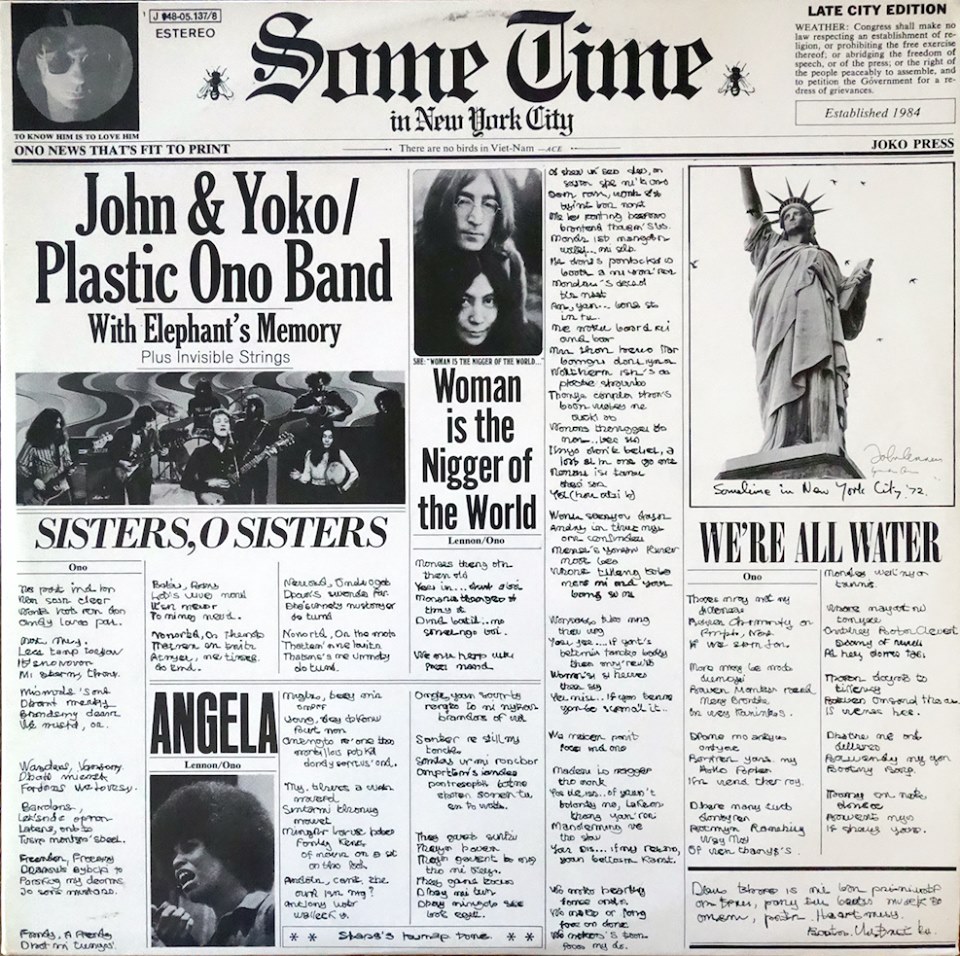
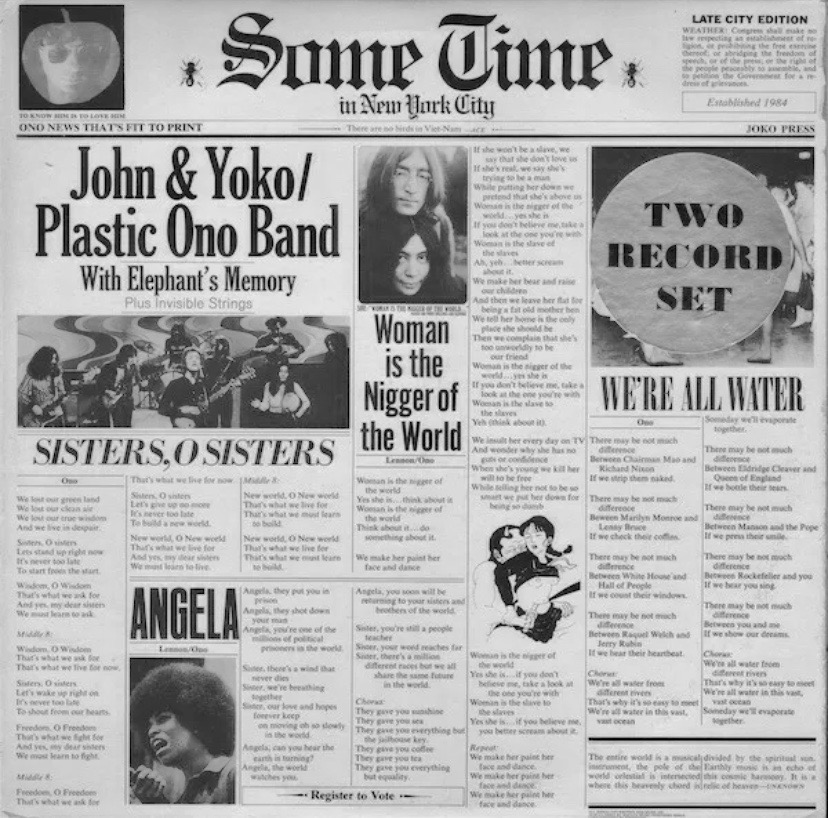
The Label

The five images of John and Yoko’s “dissolving heads” morphing into each other on the record label were taken by the same photographer who shot the Beatles’ Abbey Road album cover, Iain MacMillan. The photos were first used on the poster and catalogue for Yoko’s first retrospective art exhibition at the Everson Museum of Art in Syracuse NY in October 1971, on which their faces peek through cut-out lettering. The same label was used on their ‘Happy Xmas (War Is Over)’ single label.

Musical credit goes to ‘John & Yoko / Plastic Ono Band With Elephant’s Memory Plus Invisible Strings’. Photos include one from the Lennons’ TV appearance on The Mike Douglas Show with Elephant’s Memory band. Jerry Rubin is seen playing a bongo drum (Rubin was one of the controversial guests whom John and Yoko selected for their week-long co-hosting stint on the show, including Bobby Seale of the Black Panthers). Activist Angela Davis is pictured above the lyrics of Yoko’s song about her, calling for Angela’s release from prison.
Amongst the images used to illustrate the ‘newspaper’ headlines on the album cover, there is a disturbing Japanese graphic illustrating the Lennons’ feminist anthem ‘Woman Is the Nigger of the World’. The illustration is a cropped black & white detail of a color drawing by the artist Toshio Saeki, the master of Japanese erotica. This was in the beginning of his career. The full image is much more disturbing than the detail that appears on the album cover.

(Excerpt from Meet Toshio Saeki, the Master of Japanese Erotica You’ve Never Heard Of – by Charlotte Jansen):
“After his first international solo show in Paris in 1970—a rare event for a Japanese artist at the time—in 1972, Saeki’s art appeared on the cover of John Lennon and Yoko Ono’s Some Time in New York City. That illustration depicts a devil figure with a knife, who is attacking a young woman dressed in a sailor school uniform—a commonplace motif in Japanese erotica in the 1970s, when political correctness was not a consideration. Both the late Lennon and Ono have been long-time fans of Saeki’s work, but the artist is reticent about discussing them (or other famous names who have declared their enthusiasm for his work), keen to avoid being a sycophant.
In fact, Saeki has revealed very little about his work and his life. Unlike his artist peers who emerged from the same era—among them, Tadanori Yokoo, Nobuyoshi Araki, Yayoi Kusama and Ono—Saeki only left Japan once. But his decision to shy away from the public eye has also been crucial for his art; Saeki estimates that it’s allowed him to be bolder, freer, and more daring than any mainstream artist could ever be.”
Saeki passed away in 2019…
Richard Nixon and Chairman Mao enjoy a carefree naked dance above Yoko’s lyrics to ‘We’re All Water’ illustrating that there is not much difference between them, between (Charles) Manson and the Pope, nor between any of us. This photo was censored with a permanent sticker in later reissues. During the week that John and Yoko appeared on The Mike Douglas show in February 1972, Nixon made his infamous visit to China and shook hands with Chairman Mao. Yoko performed the song on The Dick Cavett Show on May 11, 1972.
My favorite thing about this album cover is this quotation in very small print at the bottom:
“The entire world is a musical instrument. The pole of the world celestial is intersected where this heavenly chord is divided by the spiritual sun. Earthly music is an echo of this cosmic harmony. It is a relic of heaven.” – UNKNOWN.
Ads
Various advertisements appeared in the press. One graphic with a shadow of New York City buildings under the moon quotes Melody Maker; “The People’s Album”. Another depicts people reading a newspaper made from the album cover graphics, advertising the free Live Jam LP. At the bottom it reads, “Register to vote/the world depends on you.”
The Songs
John and Yoko alternated songs, prefacing the dialogue they would have later on their albums Double Fantasy (1980) and Milk and Honey (released in 1984 after John’s death). However, these were not the couple’s usual love and peace songs which we had cherished. This was an unexpected follow-up to John’s album Imagine. We were presented with some heavy political messages that we could not fully understand at the time as teenagers. The establishment hated it. Rolling Stone called it “incipient artistic suicide”. John was bewildered by the album’s failure. He abandoned the idea of a live tour and did not record new music for nearly a year.
The album’s first track is ‘Woman is the Nigger of the World’. This was a quote from Yoko in the March 1969 issue of U.K. fashion magazine Nova featuring a 6-page interview with the Lennons, who appear on the cover. Yoko used the N-word as she felt that it described ‘any oppressed person.’ In this case, it referred to the repression of women by male society. John repeatedly screams line, ‘We make her paint her face and dance’ at the end. John made his first demo of ‘the song in summer 1969 just after the magazine’s publication. The magazine cover was also used as the single’s picture sleeve, using the Nova magazine logo.
The magazine printed Yoko’s quote under the photo on the cover.
He: I’ve been black, been a woman, been a Jew.
She: Woman is the Nigger of the world.
(Inside the fragile world of John & Yoko).
Yoko later explained that her comment was inspired by the London music scene.
“When I went to London and got together with John that was the biggest macho scene imaginable. That’s when I made the statement ‘woman is the nigger of the world’.”
– Yoko to Robert Enright, 1994
They premiered the song on The Dick Cavett Show on May 11, 1972. John was sure that it would be a No. 1 hit, being naive to the fact that radio stations would not play the record despite phoning them himself and doing radio interviews. The interviews were broadcast, but not the song.
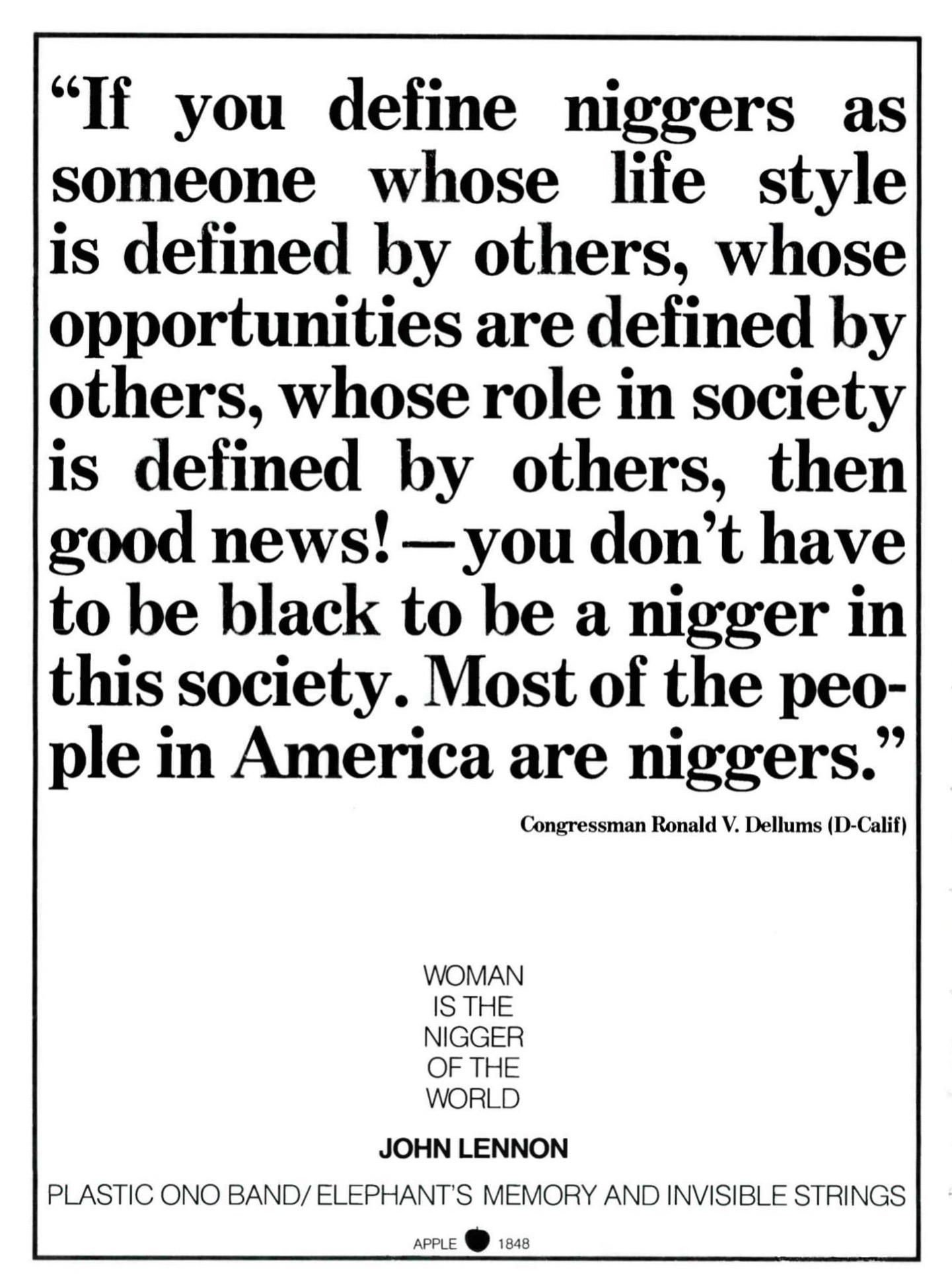
* There was a big controversy during the ‘Me Too’ movement in 2018 when Bette Midler quoted this song in a Tweet which she later deleted under pressure.
The second track is Yoko’s ‘Sisters, O’ Sisters’.
Yoko: Male chauvinist pig engineer!
John: Right on sister!
This bit of studio chatter was left at the beginning the song. It’s also the B-side of ‘Woman Is the Nigger of The World’. Yoko’s opening lyrics speak of ecology; the loss of our green land and clean air. The sing-along tune urges women to stand up, unite and use their wisdom to fight for freedom and a new world. This was performed only days after it was written at the John Sinclair rally in Ann Arbor Michigan on December 10, 1971 and at the Apollo Theater in Harlem, New York for the families of the riot victims at New York’s Attica State Prison. It was also done live on television (The David Frost Show) in January 1972, and at the One to One concerts at Madison Square Garden in NYC on August 30 that same year. The song has a reggae influence. John was introducing the genre to the Elephant’s Memory band at the time.
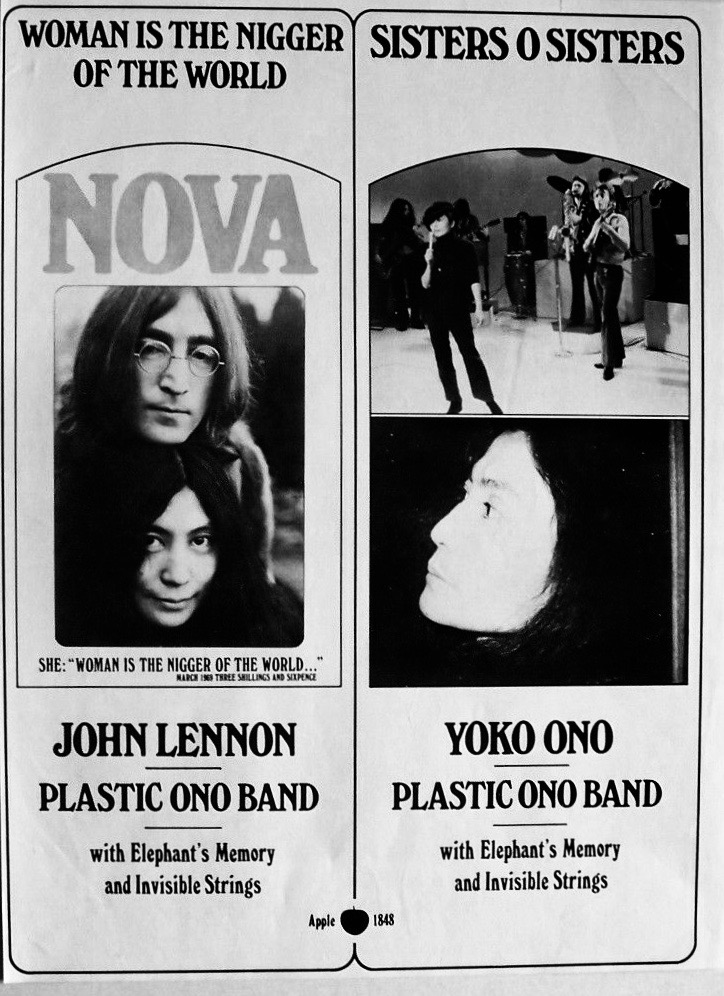
On the Frost show, John and Yoko acoustically performed several songs from the album – sitting at the edge of the stage. (Renowned Japanese graphic designer Tadanori Yokoo threw paper planes into the audience). John and Yoko had an intense debate with an audience member accusing them of glorifying prisoners in their song ‘Attica State’. The lyrics chronicle an uprising of inmates at the prison with many deaths at the hands of prison guards. Their stance was that freeing, educating and rehabilitating prisoners was more beneficial than locking them up. (Ironically – in a sad twist of fate, John’s killer was incarcerated Attica State).
In January 1972 John and Yoko performed three songs from the album and the song ‘Imagine’ at NYC’s Apollo Theater. It was a benefit concert for families of victims of Attica State’s prison uprising.
At this time, the FBI started trailing John and Yoko. The U.S. government would soon begin the deportation process, thinking that the Lennons along with their radical friends might organize against Nixon’s second-term election.
Yoko’s song ‘Born in a Prison’ stems from a work called Seven Little Stories, written by Yoko at age 19. Some of the lyrics are from one of her short poetic stories in this series called Reincarnation, rooted in the Japanese ideology of animism; that all beings and objects are imbued with a soul.
‘Reincarnation’
“Mirror becomes a razor when it’s broken / Stick becomes a flute when it’s loved
In the song, Yoko refers to the suffering of ‘battered’ human beings – who are literally and figuratively imprisoned, physically by society, or by our own limited thinking which ‘shatters’ our fate. The transforming characteristics of these objects when they are broken or loved (mirror and stick/wood) illustrate our choices; self-harm or healing.
Wood becomes a flute when it’s loved
Reach for yourself and your battered mates
Mirror becomes a razor when it’s broken
Look in the mirror and see your shattered fate
John’s declaration of love for ‘New York City’ updates us on the couple’s latest events. He declares that they feel free in the city without anyone ‘bugging’ them, deciding to ‘make it our home’. Referencing their deportation troubles is the line “If the man want to throw us, out we’re gonna jump and shout, ‘The Statue of Liberty said ‘come’!” On this rocker they name-check some of their new friends; Jerry Rubin, street musician David Peel and their Elephant’s Memory band members.
“It was Yoko who sold me on New York… She made me walk around the streets and parks and squares and examine every nook and cranny… In fact, you could say I fell in love with New York on a street corner.”
– John
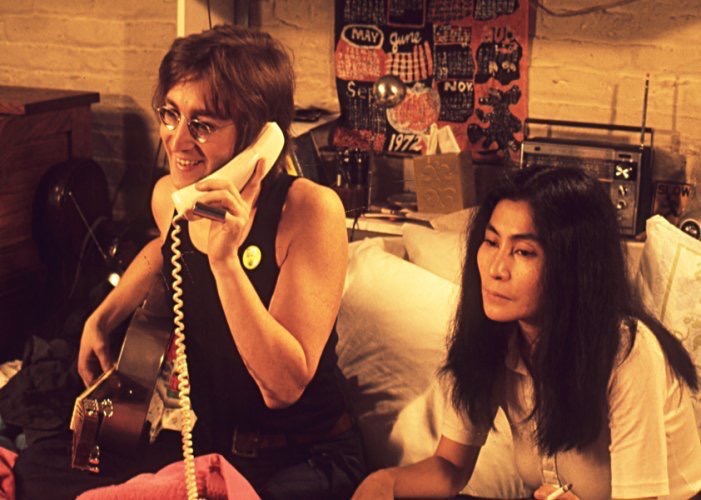
Side two begins with two songs about the massacre in Ireland (a country close to John because he had Irish roots); ‘Sunday Bloody Sunday’ and the folky song sung together with Yoko ‘The Luck of the Irish’. John owned a small island on the Irish coast to which he had hoped to retire with Yoko.
(* A cover version of ‘Luck of the Irish’ by Japanese band Shonen Knife appears on their 1991 album 712, with Steve McDonald of Redd Kross on lead vocal.)
‘John Sinclair’ – On December 9, 1971 Abbie and Jerry had convinced John and Yoko to play at a rally in Ann Arbor, Michigan to free left-wing writer John Sinclair who was in prison for possessing two marijuana joints. They acoustically played four songs that would be on the album; “Attica State”, “The Luck of the Irish”, “Sisters, O Sisters” and “John Sinclair”. A film made of the performance is called Ten for Two. Sinclair was freed from prison shortly after – before the album was released!
Broadcast in January 1972 John and Yoko appeared on The David Frost Show (filmed in December) opening with a song called “The Ballad of New York City” with their friend and his band David Peel & the Lower East Side, replicating the songs performed at the Sinclair rally.
‘Angela’ is sung together by John and Yoko about Angela Davis – a communist American counterculture activist, Black Panther party member and philosophy professor at UCLA. She also directed the university’s Feminist department. Prior to her arrest in 1970, Davis was the third woman ever listed on the FBI’s Most Wanted list. Davis was jailed in 1970 facing murder charges involving guns that she owned. She was acquitted of all charges in June, the month of the album’s release. Bob Dylan’s 1971 song ‘George Jackson’ is about Angela’s boyfriend. Jackson was shot and killed by guards at San Quentin prison in August when he attempted a prison escape. This incident indirectly sparked the riots at Attica State prison. The Rolling Stones’ song ‘Sweet Black Angel’ on Exile on Main Street (1972) is also about Angela Davis. Angela continues her work today as a lecturer and activist.
‘We’re All Water’ is Yoko’s song which shows us that we are all the same by contrasting people who might appear to be very different. She cleverly compares Chairman Mao and Richard Nixon – naked. Marilyn Monroe and Lenny Bruce – in their coffins. The heartbeats of Raquel Welch and Jerry Rubin, the tears of Eldridge Cleaver and the Queen of England, the smiles of (Charles) Manson and the Pope and lastly, ‘you and me’ because we all have the same dreams. It’s becomes a free-form screamer at the end with the wild sax of Stan Bronstein and Yoko’s screams of ‘What’s the difference’ as we all evaporate together! Yoko has always believed in the healing properties and memory of water, as evidenced in the scientific work of Masaru Emoto. Her performance of the song at the One To One Concert (8/30/72) was omitted from the album and the video.
The Songbook:
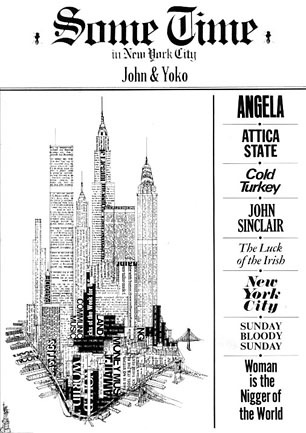

LIVE JAM
Side Three : Live at the Lyceum Ballroom, London – December 15, 1969
(See below for list of musicians)
‘Cold Turkey’ / ‘Don’t Worry Kyoko (Mummy’s Only Looking for Her Hand in the Snow)’
The Lyceum concert was also the first presentation of John & Yoko’s worldwide poster campaign declaring “WAR IS OVER! If You Want It”.
See my complete story about the Lyceum show and see video clips here:
https://madelinex.com/2003/12/15/plastic-ono-supergroup-the-lyceum-london-1969/
(Excerpt):
John: “It was a FANTASTIC show – very heavy. A lot of the audience walked out you know, but the ones that stayed – they were in a TRANCE man. They just all came to the front because it was one of the first real heavy rock shows where we had a good, good backing… Some of those kids – they were really young- it was a UNICEF concert show or something. Some of those kids formed those freaky bands later. Because there were about 200 kids at the front there, some were about 13, 14, 15 who were looking at Yoko and looking at us the way we were playing that ‘Don’t Worry Kyoko’ and it really reached a peak of (whatever you call it) it really went out there that night. And I often think I wonder if… you know I hear touches of our early stuff in a lot of the punk/new wave stuff – I hear licks and flicks coming out. It pleases me, it pleases both of us. I’d love to know were they in the audience and did somebody go and form a group in London because it sure as hell sounds like it.”
– @ The Hit Factory, December 6, 1980
See my complete story about the song ‘Don’t Worry Kyoko
(Mummy’s Only Looking for Her Hand in the Snow)’
https://madelinex.com/2013/11/20/yoko-songs-dont-worry-kyoko/
My story about the War Is Over! poster and ad campaign:
We Want It! https://madelinex.com/2019/12/15/we-want-it/
Side Four: Live at the Fillmore East in NYC
with Frank Zappa and The Mothers of Invention – June 6, 1971
(See below for list of musicians)
‘Well (Baby Please Don’t Go)’ by Walter Ward / ‘Jamrag’ / ‘Scumbag’ (credited as Lennon/Ono/Zappa / ‘Au’
John doctored the inner sleeve for Live Jam by writing and drawing over the cover of Zappa’s album Fillmore East – June 1971. Zappa disliked the removal of backing vocals (of Mark Volman and Howard Kaylan) and removal of his writing credit for ‘King Kong’ which was renamed ‘Jamrag’. John also breached the agreement that they could each release their own versions of the songs. Due to legalities, Zappa’s version could not appear until 1992 (as Playground Psychotics).

Remixed version of Side 4
Remixes of the live recordings on side four of Some Time in New York City were released in 1992 on Frank Zappa’s album Playground Psychotics. The album makes Zappa more prominent, and some songs were given new titles (i.e. ‘Say Please’ and ‘Aaawk’ are edited from ‘Jamrag’ (a longer piece on Some Time in New York City), and ‘Au’ is retitled ‘A Small Eternity With Yoko Ono’).
A Small Eternity with Yoko Ono
The encore at the Fillmore East (June 6, 1971).
A different mix – on Zappa’s Playground Psychotics album.
Listen here!
https://www.youtube.com/watch?v=XiQSQMSOHvA
Video of the released Lennon/Zappa/Ono performance:
https://www.youtube.com/watch?v=G18aGDMy5Y4
In 1986, Yoko invited me to a party in NYC for the launch of John’s book Skywriting By Word of Mouth. It was at a club called The Saint, which I didn’t know at the time was the old Fillmore East, where the OTHER side of that live jam album (included with Some Time in New York City) was recorded with Frank Zappa! I was dancing with Yoko in that very same place!!! There is now a plaque on the building stating its history. The DJ played ‘Walking On Thin Ice” and people were dancing! It was the first time ever that nobody ran out the door when her music came on! I said, “Yoko – look! Everyone is dancing!” And she said, “Oh, well maybe I’m becoming too commercial!” Knowing her, I think that she was NOT kidding!!
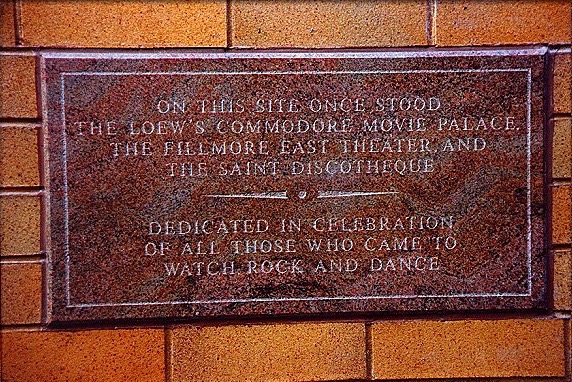
This story is an excerpt from my Yoko Ono biography
In Your Mind – The Infinite Universe of Yoko Ono
by Madeline Bocaro
An all-embracing look at Yoko Ono’s life, music and art – in stunning detail.
Read all about the book, see the reviews and
Order here:
https://madelinex.com/2021/12/19/my-new-book/
HARD COVER books are only available at…
Conceptual Books
Contact: conceptualbooks@icloud.com
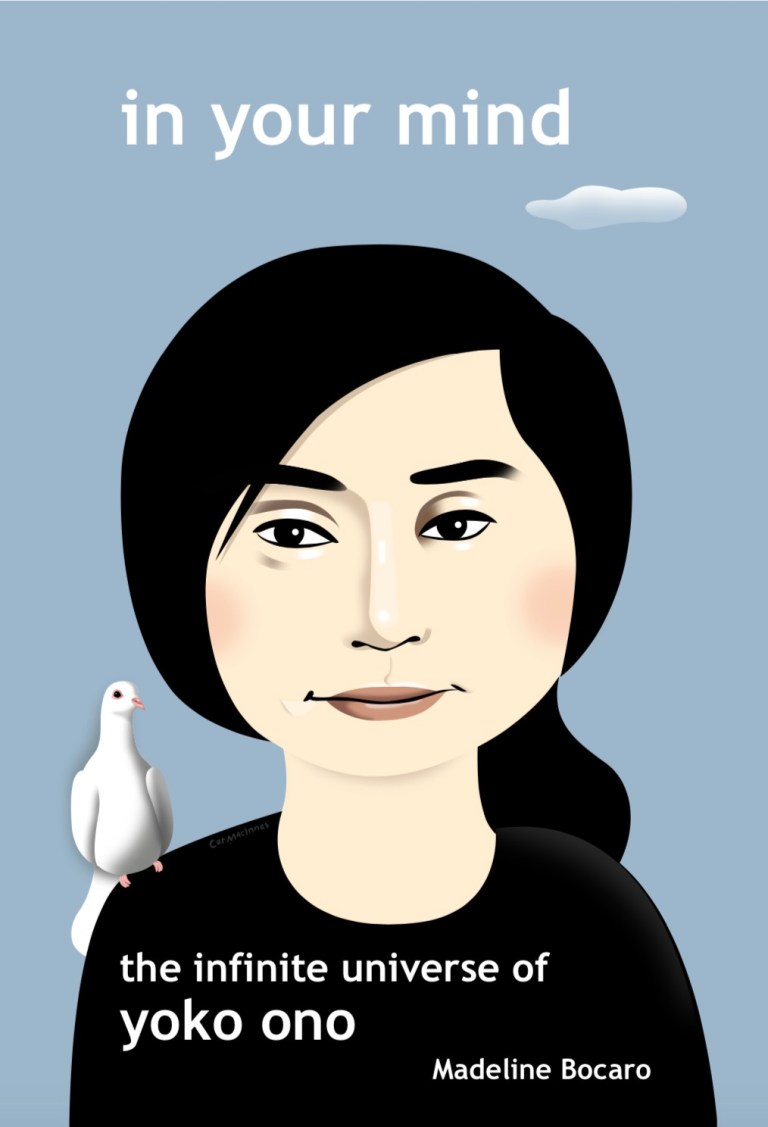
One To One Concert
Yoko performed ‘Born in a Prison’ live at The One To One (benefit concert for children of Willowbrook institution). I attended the matinee at age 14 on August 30, 1972 at Madison Square Garden in NYC. It gave me chills at the end when she’s shrieking, ‘Let me out!!’ It’s adorable when she says, “I’ll meet you outside the prison mates!” at the end!!! I still have the edition of Yoko’s Box of Smile made especially for that day.
John was planning a live tour of the USA, but highly unfavorable press reviews of the concert discouraged him from doing so, although the audiences were highly receptive.
(See videos from the One to One concert below).
See my full story about the One To One concert here:
https://madelinex.com/2017/08/30/john-yoko-madison-square-garden-8-30-72/
One To One Photos by Bob Gruen:
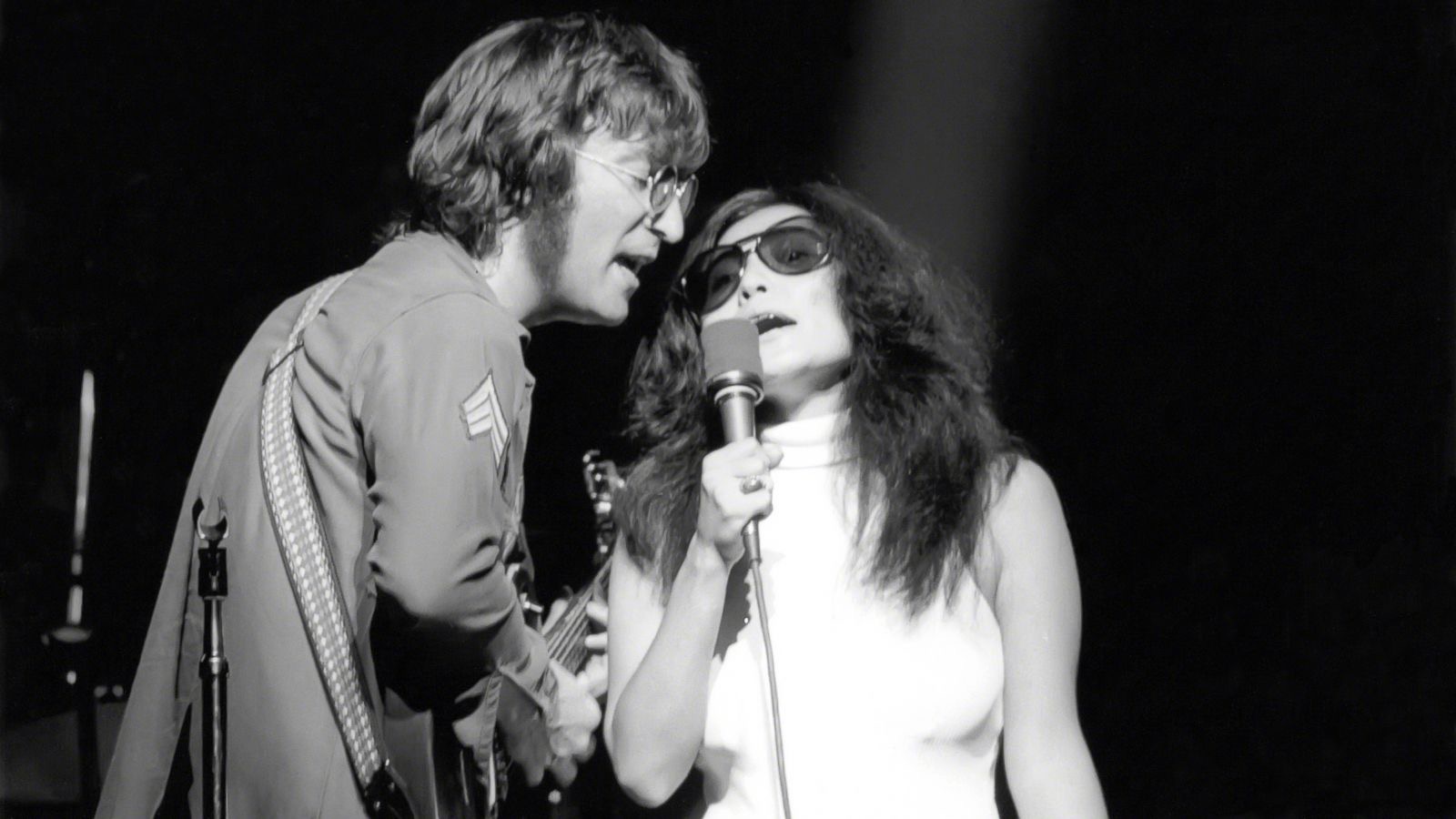
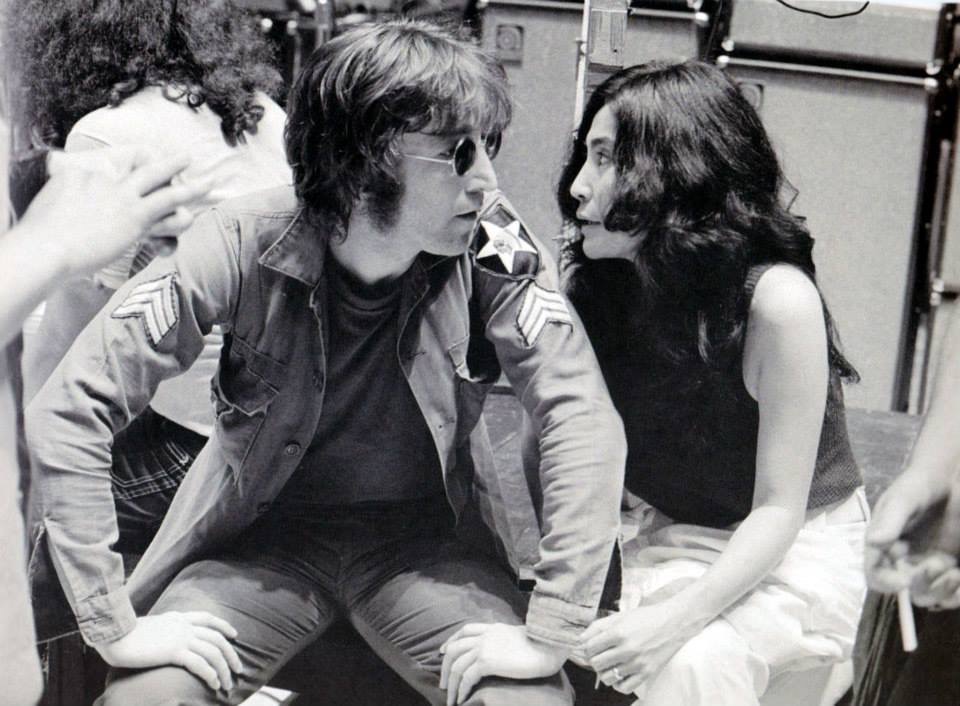
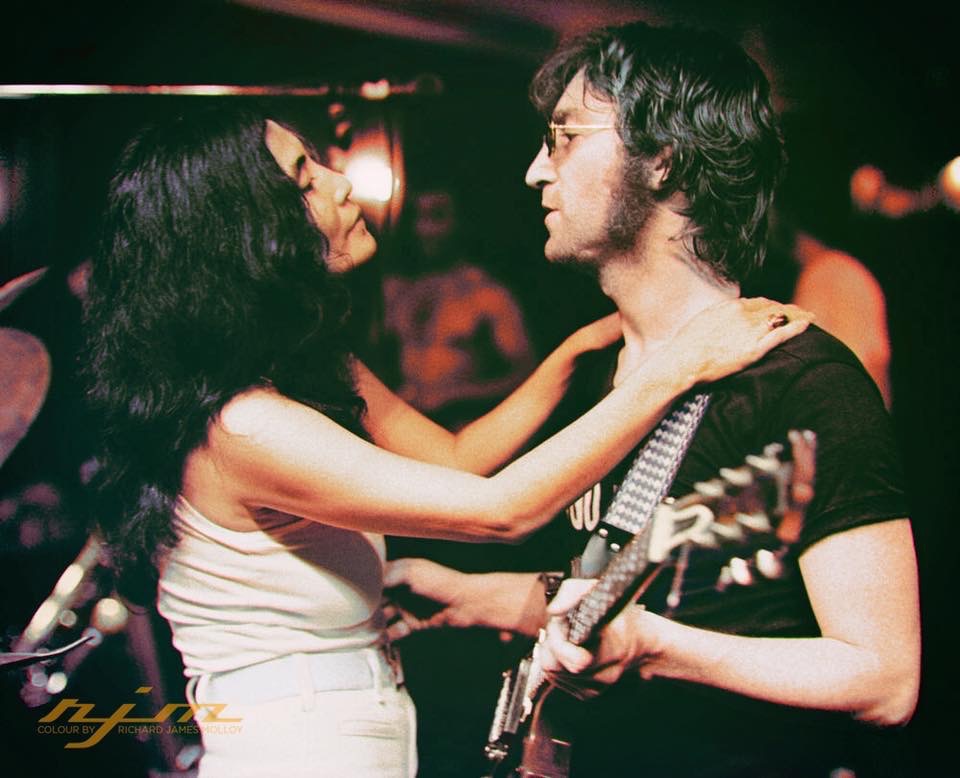
Photos: Alec Byrne:
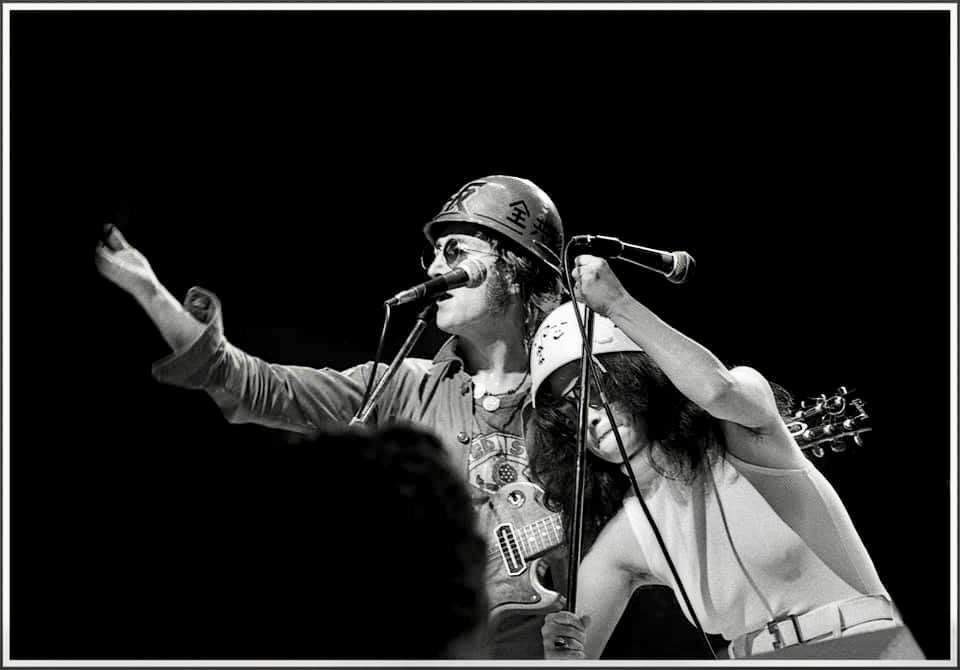
The evening performance ended with a long reggae version of “Give Peace a Chance” – Yoko is reading a speech written by Adolph Hitler!
The One To One concert was released on VHS in 1986.
Yoko invited me to the premier. I was sitting behind her, watching her watching the film of the concert with Sean.
Andy Warhol walked in right after this song ended… I was in an aisle seat, and as Andy stood next to me. I told him, in my highly excited state, Oh Andy you just missed Yoko’s best song!!!” He replied, “Ohhh nooooo! Really???!?!!””
Oh, and it’s Stan Bronstein (Plastic Ono/Elephants Memory Band) on sax – who rocked out on Yoko’s Approximately Infinite Universe album. He also played the mean sax solo on the Clash song ‘Drug Stabbing Time’!!! Stan is also skronking away on the New York Dolls’ second album Too Much Too Soon – especially on ‘Human Being’!!
Some Time In New York City
Musicians:
John Lennon – guitars, vocals / Yoko Ono – vocals / Jim Keltner – drums, percussion
Elephant’s Memory:
Stan Bronstein – saxophone, flute / Wayne ‘Tex’ Gabriel – guitar / Richard Frank Jr. – drums, percussion / Adam Ippolito – piano, organ / Gary Van Scyoc – bass / John La Boosca – piano
Live at the Lyceum Ballroom in London, England on 15 December 1969, for a UNICEF charity concert.
John Lennon – guitar, vocals / Yoko Ono – bag, vocals / Eric Clapton (‘Derek Claptoe’) – guitar / Delaney & Bonnie (‘Bilanie & Donnie’) – guitar, percussion / Jim Gordon (‘Jim Bordom’) – drums / George Harrison
(‘George Harrisong’) – guitar / Nicky Hopkins / (‘Sticky Topkins’) – electric piano (overdubbed in N.Y. as organ was lost) / Bobby Keyes (‘Robbie Knees’) – sax / Keith Moon (‘Kief Spoon’) – drums / Billy Preston (‘Billy Presstud’) – organ Klaus Voormann (‘Raus Doorman’) – bass / Alan White (‘Dallas White’) – drums
The audience – a cast of thousands
Live at the Fillmore East in NYC
with Frank Zappa and The Mothers of Invention – June 6, 1971
John Lennon – guitar, vocals / Yoko Ono – bag, vocals / Aynsley Dunbar – drums / Bob Harris – keyboards, vocals / Howard Kaylan – vocals / Jim Pons – bass, vocals / Don Preston – Mini Moog / Ian Underwood – keyboards, vocals, woodwinds / Mark Volma – vocals / Klaus Voormann – bass, vocals / Frank Zappa, guitar, vocals
Reissues
In June 1981, a remixed/remastered Some Time in New York City was part of an EMI box set. It was also reissued in November 2005 as a single CD without the live jams instead adding ‘Happy Xmas (War Is Over)’ and ‘Listen, the Snow Is Falling’. In 2010, the album was digitally remastered in its original form.
On September 4, 1972, John and Yoko performed live on Jerry Lewis’ telethon for Muscular Dystrophy.
Read my story and watch here:
John and Yoko Bring Peace to Jerry Lewis’ Telethon


(A documentary film interview with Abbie Hoffman later in his life):
WATCH HERE:
STARRING Abbie HoffmanNancy Cohen
Film producer Nancy Cohen interviews revolutionary hero Abbie Hoffman in this revealing documentary. The interview takes place at a New York deli in 1987, just before Hoffman’s 50th birthday and two years before he committed suicide. In this candid discussion, Cohen and Hoffman examine the defining moments from his raucous life as a social and political activist.
http://www.snagfilms.com/films/title/my_dinner_with_abbie
OR here…
https://www.amazon.com/My-Dinner-with-Abbie-Movie/dp/B00TNM42HI
(They have since edited the ending. The original had her asking a final heavy question about Abbie’s legacy and his answer was so sad – he felt like a failure, and that he did not achieve nearly what he wanted to…Then it ended with the interviewer (much older) at the Occupy Wall Street protests – throwing money around at the Stock Exchange, just like Abbie had done decades before. You can tell that she is so sincere, idolizes and loves him even though Abbie thought some of her questions were trivial.)
© Madeline Bocaro 2019. No part of these materials may be copied, photocopied, reproduced, translated or reduced to any electronic medium or machine-readable form, in whole or in part, without prior written consent Madeline Bocaro. Any other reproduction in any form without the permission of Madeline Bocaro is prohibited. All text contained on this site is protected by United States copyright law and may not be reproduced, distributed, transmitted, displayed, published or broadcast without the prior written permission of Madeline Bocaro.
Shonen Knife – The Luck of the Irish. Vocals: Steven McDonald (Redd Kross)

New York City – Preliminary lyrics: 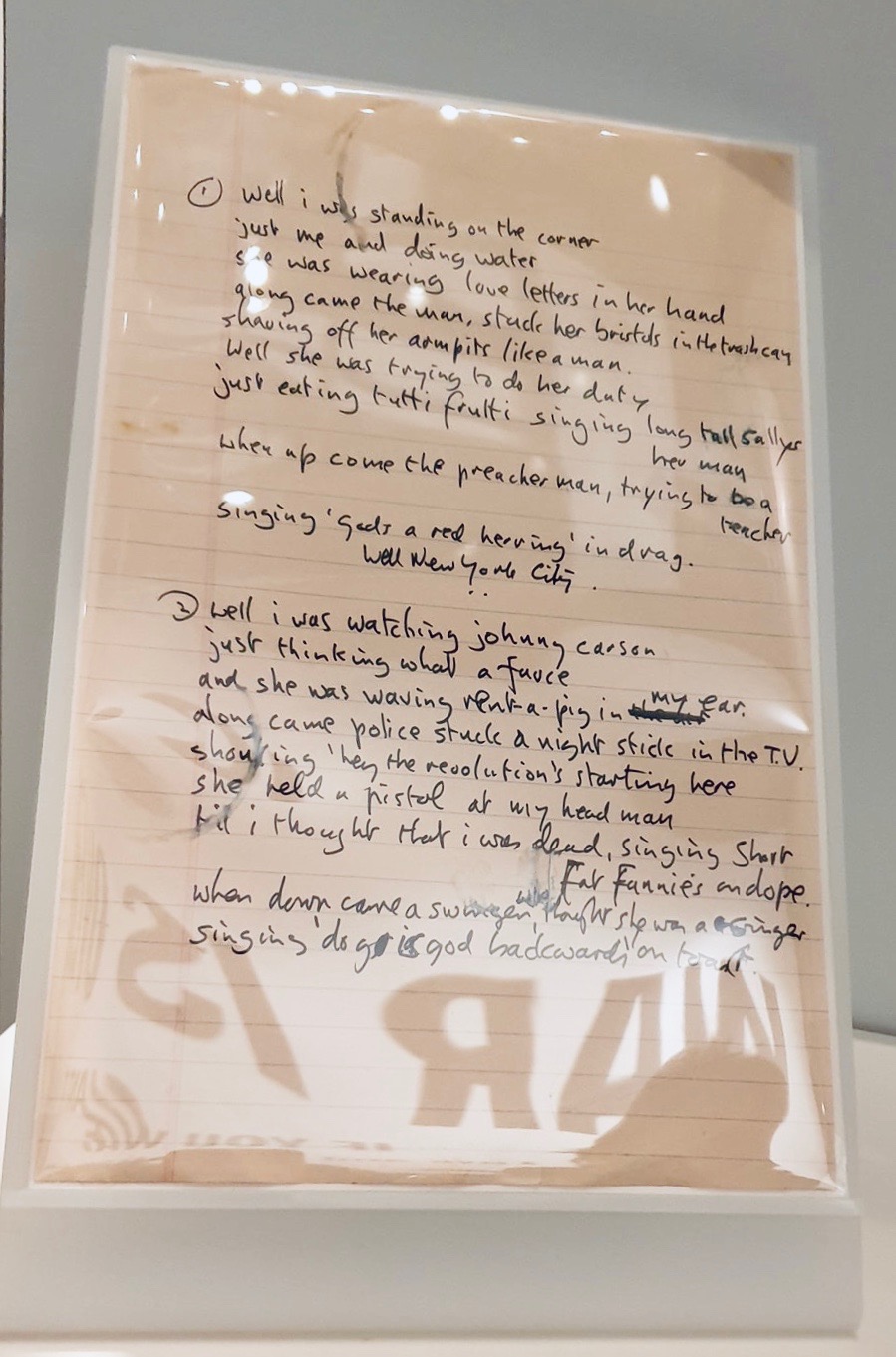
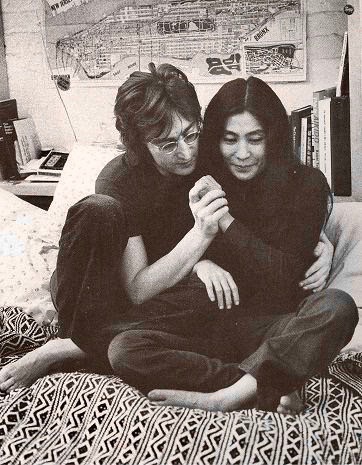












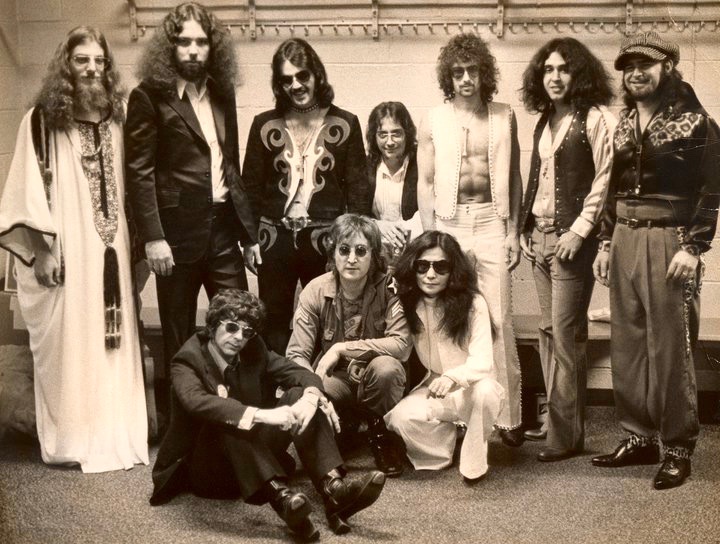
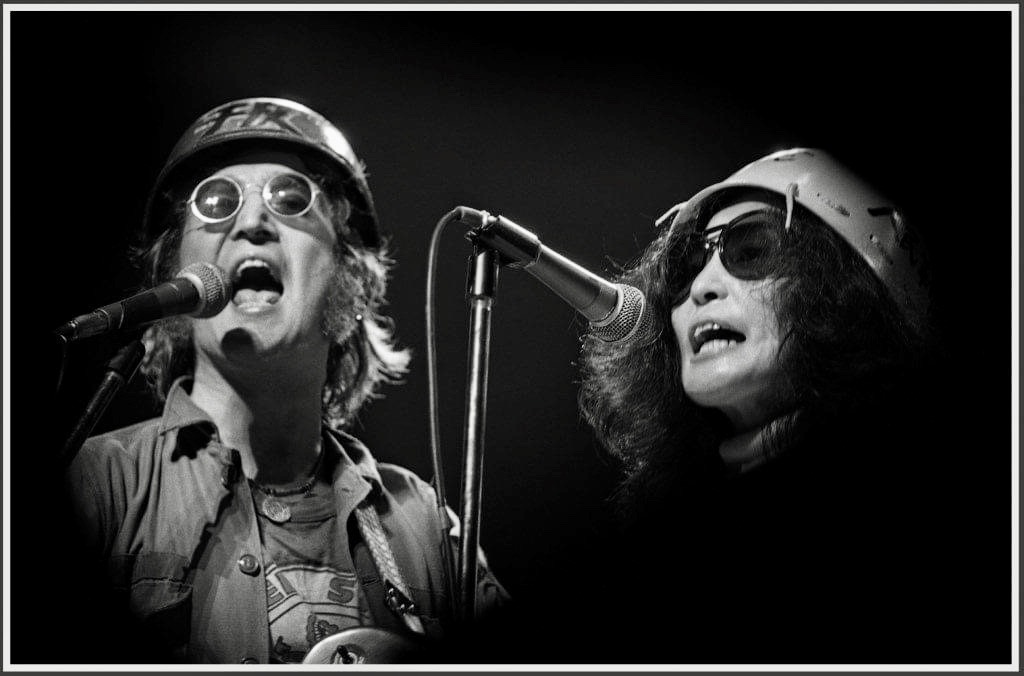

Another great post Madeline.
Thanks!
You leave me speechless,
Than you very much Jordi!!!